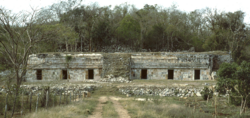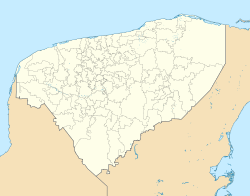Chacmultun facts for kids

First storey of the Cabalpak building
|
|
| Location | Yucatán, |
|---|---|
| Region | Yucatán |
| Coordinates | 20°10′17″N 89°20′41″W / 20.17139°N 89.34472°W |
Chacmultun is an amazing ancient Maya city in Mexico's Yucatán region. It was built a very long time ago, during the Late Preclassic period of Maya history. The name "Chacmultun" means "mounds of red stone" in the Maya language. This is because the buildings there have a special reddish color! This old city is about 126 kilometers (about 78 miles) away from the modern city of Mérida.
Contents
Discovering Chacmultun's Secrets
Chacmultun is famous for its unique red stone buildings. This special color comes from tiny living things, called microorganisms, that lived in the stone. When these microorganisms touched air and water, they turned red!
Who Found Chacmultun?
An explorer from Austria named Teobert Maler first found this site in the 1800s. Later, in the 1970s, archaeologists carefully dug up and studied the city in detail. This helped us learn a lot about how the Maya lived there.
Layout of the Ancient City
The main part of Chacmultun covers about one square kilometer. The city is divided into four main areas: Chacmultun, Cabalpak, Xetpol, and the Central district. The Maya people were very clever. They built these groups of buildings on hills or on special raised platforms. This made the buildings look even bigger and more important!
Trade and Connections
Chacmultun was an important city. It is believed that the people of Chacmultun traded with many other Maya cities nearby. Some of these cities include Edzna, Oxkintok, Uxmal, and Kabah. Trading helped these ancient cities grow and share ideas.
Rare Maya Art
Some of the buildings at Chacmultun still have ancient Maya paintings, called murals, inside them. These murals are very special because they are quite rare to find preserved in Maya sites. They give us clues about the art and stories of the Maya people.
When Chacmultun Was Important
Chacmultun was at its busiest and most powerful during the Late Classic period. This was around the 10th century. The buildings you see there are built in a special style called Puuc. This style often includes fancy decorations, like detailed carvings called friezes, on the upper parts of the buildings. People continued to live in Chacmultun for a long time, right up until the 15th century.
See also
 In Spanish: Chacmultún para niños
In Spanish: Chacmultún para niños


